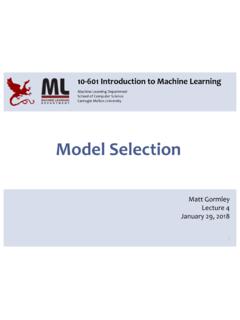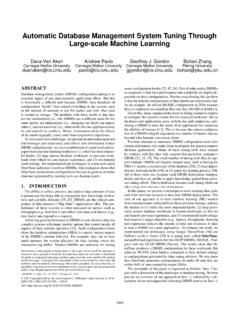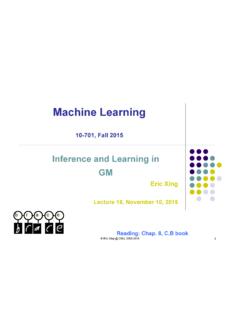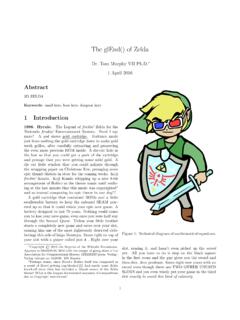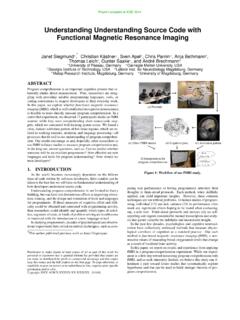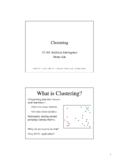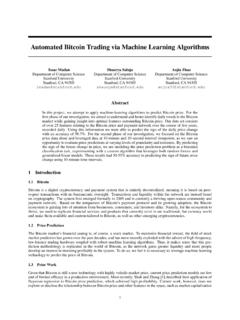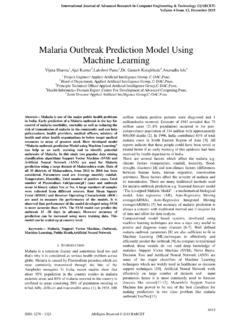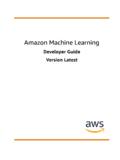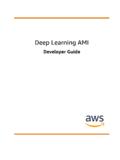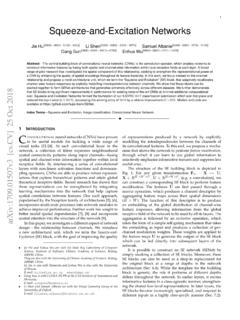Transcription of Sponsored Search Acution Design Via Machine …
1 Maria-Florina Balcan 03/30/2015 Semi-Supervised learning Readings: Semi-Supervised learning . Encyclopedia of Machine learning . Jerry Zhu, 2010 Combining Labeled and Unlabeled Data with Co-Training. Avrim Blum, Tom Mitchell. COLT 1998. Labeled Examples Fully Supervised learning learning Algorithm Expert / Oracle Data Source Distribution D on X c* : X ! Y (x1,c*(x1)),.., (xm,c*(xm)) h : X ! Y x1 > 5 x6 > 2 +1 -1 +1 + - + + + - - - - - Labeled Examples learning Algorithm Expert / Oracle Data Source Distribution D on X c* : X ! Y (x1,c*(x1)),.., (xm,c*(xm)) h : X ! Y Goal: h has small error over D. errDh=Prx~ D(hx c (x)) Sl={(x1,y1), ..,(xml,yml)} xi drawn from D, yi=c (xi) Fully Supervised learning Two Core Aspects of Supervised learning Algorithm Design . How to optimize? Automatically generate rules that do well on observed data.
2 Confidence Bounds, Generalization Confidence for rule effectiveness on future data. Computation (Labeled) Data : Na ve Bayes, logistic regression, SVM, Adaboost, etc. VC-dimension, Rademacher complexity, margin based bounds, etc. Classic Paradigm Insufficient Nowadays Modern applications: m a s s i v e a m o u n t s of raw data. Only a tiny fraction can be annotated by human experts. Billions of webpages Images Protein sequences Modern applications: m a s s i v e a m o u n t s of raw data. Modern ML: New learning Approaches Expert Semi-supervised learning , (Inter)active learning . Techniques that best utilize data, minimizing need for expert/human intervention. Paradigms where there has been great progress. Labeled Examples Semi-Supervised learning learning Algorithm Expert / Oracle Data Source Unlabeled examples Algorithm outputs a classifier Unlabeled examples Sl={(x1,y1).}
3 ,(xml,yml)} Su={x1, ..,xmu} drawn from D xi drawn from D, yi=c (xi) Goal: h has small error over D. errDh=Prx~ D(hx c (x)) Semi-supervised learning Test of time awards at ICML! Workshops [ICML 03, ICML 05, ..] Semi-Supervised learning , MIT 2006 O. Chapelle, B. Scholkopf and A. Zien (eds) Books: Introduction to Semi-Supervised learning , Morgan & Claypool, 2009 Zhu & Goldberg Major topic of research in ML. Several methods have been developed to try to use unlabeled data to improve performance, : Transductive SVM [Joachims 99] Co-training [Blum & Mitchell 98] Graph-based methods [B&C01], [ZGL03] Semi-supervised learning Test of time awards at ICML! Major topic of research in ML. Several methods have been developed to try to use unlabeled data to improve performance, : Transductive SVM [Joachims 99] Co-training [Blum & Mitchell 98] Graph-based methods [B&C01], [ZGL03] Both wide spread applications and solid foundational understanding!
4 !! Semi-supervised learning Test of time awards at ICML! Major topic of research in ML. Several methods have been developed to try to use unlabeled data to improve performance, : Transductive SVM [Joachims 99] Co-training [Blum & Mitchell 98] Graph-based methods [B&C01], [ZGL03] Today: discuss these methods. Very interesting, they all exploit unlabeled data in different, very interesting and creative ways. Unlabeled data useful if we have beliefs not only about the form of the target, but also about its relationship with the underlying distribution. Key Insight Semi-supervised learning : no querying. Just have lots of additional unlabeled data. A bit puzzling; unclear what unlabeled data can do for It is missing the most important info. How can it help us in substantial ways? Semi-supervised SVM [Joachims 99] Margins based regularity + + _ _ Labeled data only + + _ _ + + _ _ Transductive SVM SVM Target goes through low density regions (large margin).
5 Assume we are looking for linear separator belief: should exist one with large separation Transductive Support Vector Machines Optimize for the separator with large margin wrt labeled and unlabeled data. [Joachims 99] argminw w2 : yi w xi 1, for all i {1,..,ml} Su={x1, ..,xmu} yu w xu 1, for all u {1,..,mu} yu { 1,1} for all u {1,..,mu} 0 + + + + - - - 0 + - - - - w = 1 =1 0 0 0 0 0 0 0 0 0 0 0 0 0 0 0 0 0 0 0 0 0 0 0 0 0 0 0 0 0 0 0 0 0 0 0 0 0 0 0 0 0 0 0 0 0 0 0 0 0 0 0 0 0 0 0 0 0 0 0 0 0 0 0 0 0 0 0 0 0 0 0 0 Input: Sl={(x1,y1), ..,(xml,yml)} Find a labeling of the unlabeled sample and separates both labeled and unlabeled data with maximum margin. Transductive Support Vector Machines argminw w2+ + yi w xi 1- , for all i {1,..,ml} Su={x1.}
6 ,xmu} yu w xu 1 , for all u {1,..,mu} yu { 1,1} for all u {1,..,mu} 0 + + + + - - - 0 + - - - - w = 1 =1 0 0 0 0 0 0 0 0 0 0 0 0 0 0 0 0 0 0 0 0 0 0 0 0 0 0 0 0 0 0 0 0 0 0 0 0 0 0 0 0 0 0 0 0 0 0 0 0 0 0 0 0 0 0 0 0 0 0 0 0 0 0 0 0 0 0 0 0 0 0 0 0 Input: Sl={(x1,y1), ..,(xml,yml)} Find a labeling of the unlabeled sample and separates both labeled and unlabeled data with maximum margin. Optimize for the separator with large margin wrt labeled and unlabeled data. [Joachims 99] Transductive Support Vector Machines Optimize for the separator with large margin wrt labeled and unlabeled data. argminw w2+ + yi w xi 1- , for all i {1,..,ml} Su={x1, ..,xmu} yu w xu 1 , for all u {1,..,mu} yu { 1,1} for all u {1,..,mu} 0 Input: Sl={(x1,y1), ..,(xml,yml)} Convex only after you guessed the too many possible Transductive Support Vector Machines Optimize for the separator with large margin wrt labeled and unlabeled data.
7 Heuristic (Joachims) high level idea: Keep going until no more improvements. Finds a locally-optimal solution. First maximize margin over the labeled points Use this to give initial labels to unlabeled points based on this separator. Try flipping labels of unlabeled points to see if doing so can increase margin Experiments [Joachims99] Highly compatible + + _ _ Helpful distribution Non-helpful distributions Transductive Support Vector Machines 1/ 2 clusters, all partitions separable by large margin Margin satisfied Margin not satisfied Different type of underlying regularity assumption: Consistency or Agreement Between Parts [Blum & Mitchell 98] Co-training Co-training: Self-consistency My Advisor Prof. Avrim Blum My Advisor Prof. Avrim Blum x1- Text info x2- Link info x - Link info & Text info x = h x1, x2 i Agreement between two parts : co-training [Blum-Mitchell98].
8 - examples contain two sufficient sets of features, x = h x1, x2 i For example, if we want to classify web pages: - belief: the parts are consistent, 9 c1, c2 c1(x1)=c2(x2)=c*(x) as faculty member homepage or not my advisor Idea: Use unlabeled data to propagate learned information. Idea: Use small labeled sample to learn initial rules. , my advisor pointing to a page is a good indicator it is a faculty home page. , I am teaching on a page is a good indicator it is a faculty home page. Iterative Co-Training Idea: Use unlabeled data to propagate learned information. Idea: Use small labeled sample to learn initial rules. , my advisor pointing to a page is a good indicator it is a faculty home page. , I am teaching on a page is a good indicator it is a faculty home page. Iterative Co-Training Look for unlabeled examples where one rule is confident and the other is not.
9 Have it label the example for the other. hx1,x2i hx1,x2i hx1,x2i hx1,x2i hx1,x2i hx1,x2i Training 2 classifiers, one on each type of info. Using each to help train the other. Iterative Co-Training Have learning algos A1, A2 on each of the two views. Use labeled data to learn two initial hyp. h1, h2. Look through unlabeled data to find examples where one of hi is confident but other is not. Have the confident hi label it for algorithm A3-i. Repeat + + + X1 X2 Works by using unlabeled data to propagate learned information. h h1 Original Application: Webpage classification 12 labeled examples, 1000 unlabeled (sample run) Iterative Co-Training A Simple Example: learning Intervals c2 c1 Use labeled data to learn h11 and h21 Use unlabeled data to bootstrap h11 h21 Labeled examples Unlabeled examples h12 h21 h12 h22 + - - Expansion, Examples: learning Intervals c1 c2 D+ c1 c2 Consistency: zero probability mass in the regions Non-expanding (non-helpful) distribution Expanding distribution c1 c2 D+ S1 S2 Co-training: Theoretical Guarantees What properties do we need for co-training to work well?
10 We need assumptions about: underlying data distribution learning algos on the two sides [Blum & Mitchell, COLT 98] 1. Independence given the label 2. Alg. for learning from random noise. [Balcan, Blum, Yang, NIPS 2004] expansion. 2. Alg. for learning from positve data only. 1+ 2+ 1 2 View 1 View 2 Co-training [BM 98] Say that 1 is a weakly-useful predictor if Pr 1 =1 1 =1>Pr 1 =1 1 =0+ . Theorem: if is learnable from random classification noise, we can use a weakly-useful 1 plus unlabeled data to create a strong learner under independence given the label. Say we have enough labeled data to produce such a starting point. Has higher probability of saying positive on a true positive than it does on a true negative, by at least some gap Co-training: Benefits in Principle [BB 05]: Under independence given the label, any pair 1, 2 with high agreement over unlabeled data must be close to: 1, 2, 1, 2 , , , or , 1+ 2+ 1 2 View 1 View 2 1+ 2+ 1 2 View 1 View 2 Co-training: Benefits in Principle [BB 05]: Under independence given the label, any pair 1, 2 with high agreement over unlabeled data must be close to: 1, 2, 1, 2 , , , or , Because of independence, we will see lot , Co-training/Multi-view SSL: Direct Optimization of Agreement argminh1,h2 l(hlxi,yi)mli=12l=1+C agreement(h1xi,h2xi)mui=1 Su={x1.}
